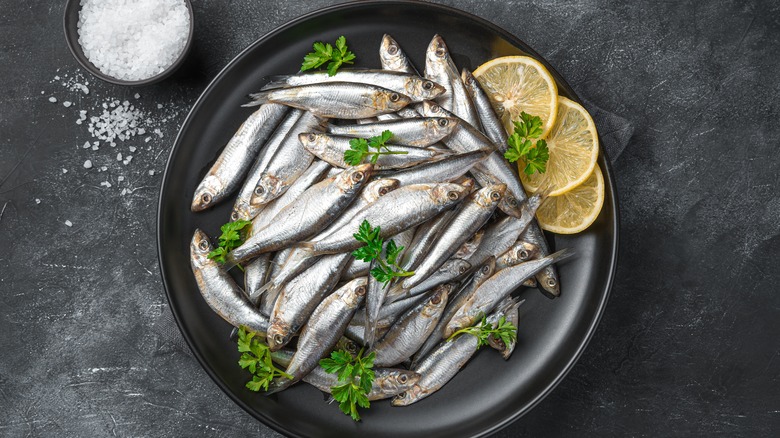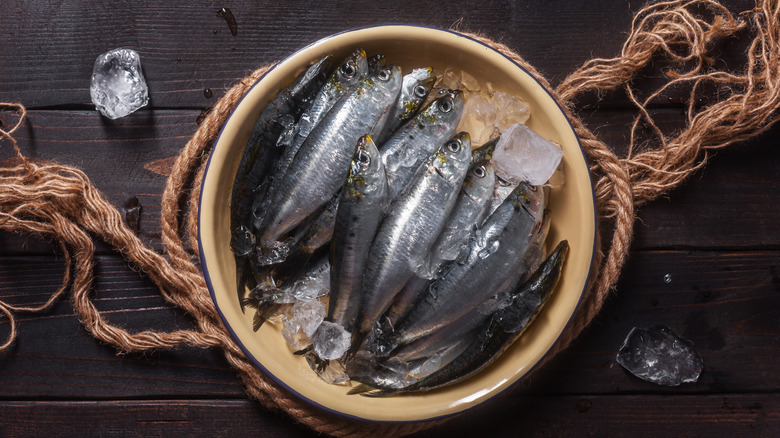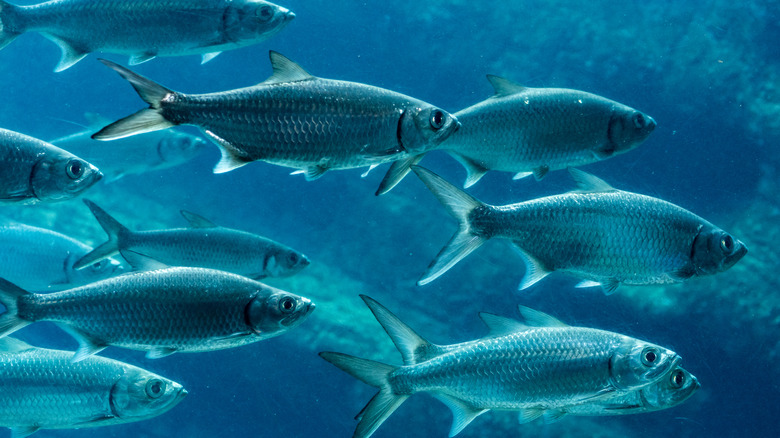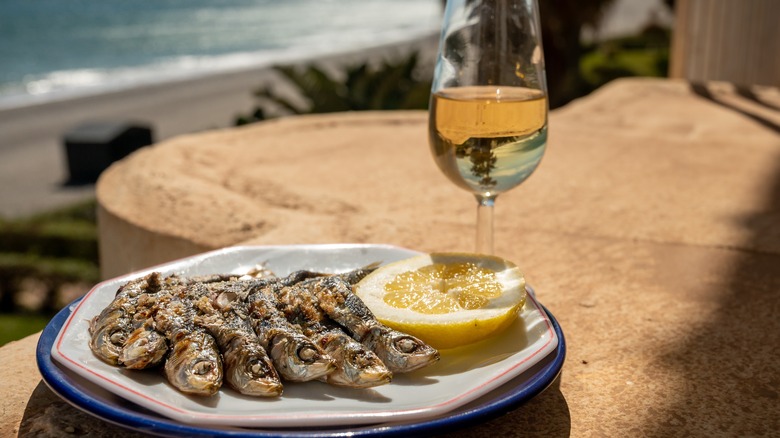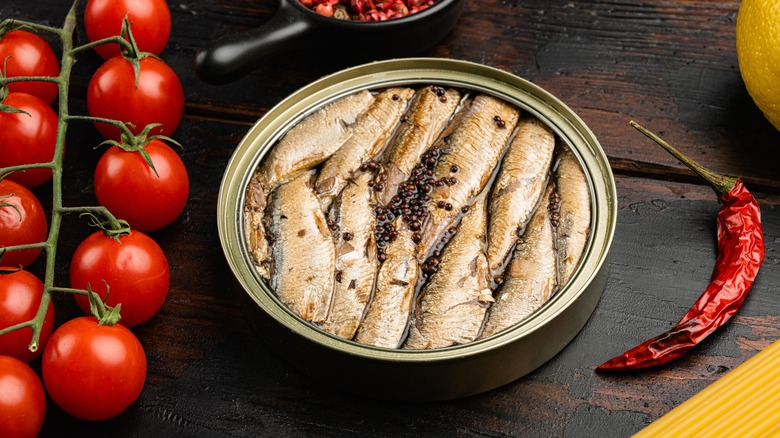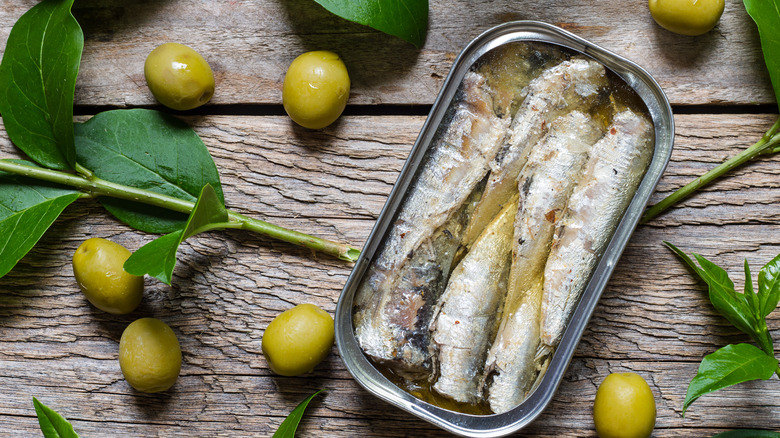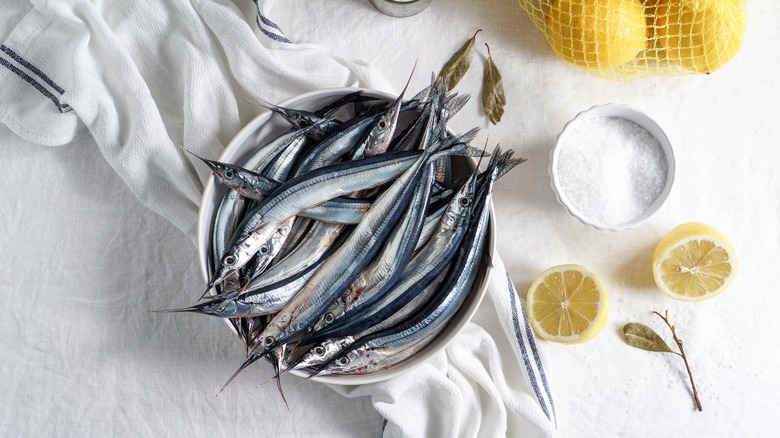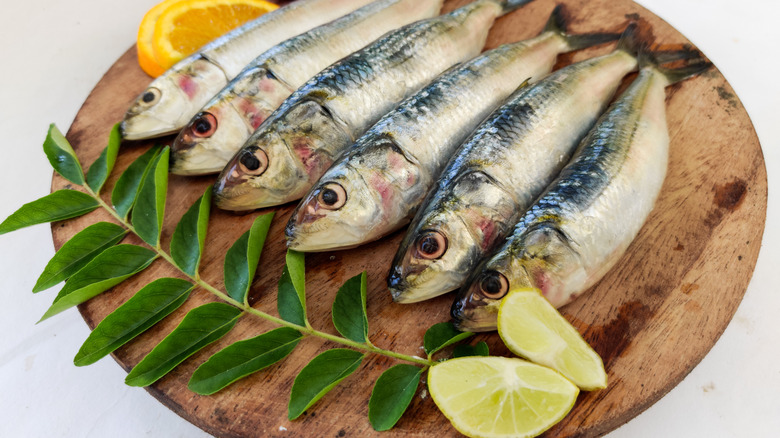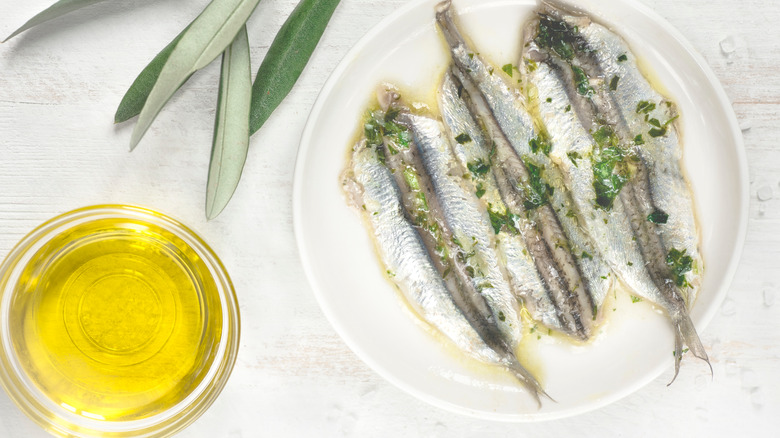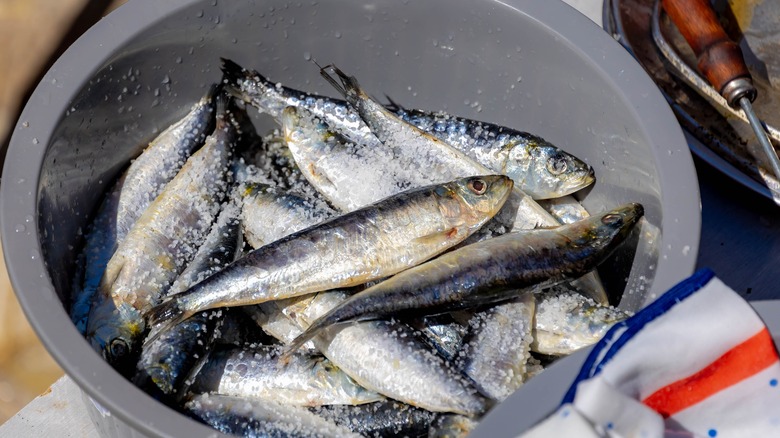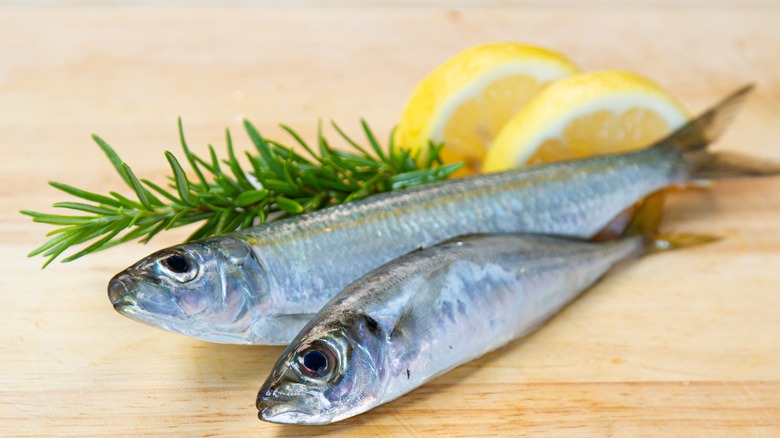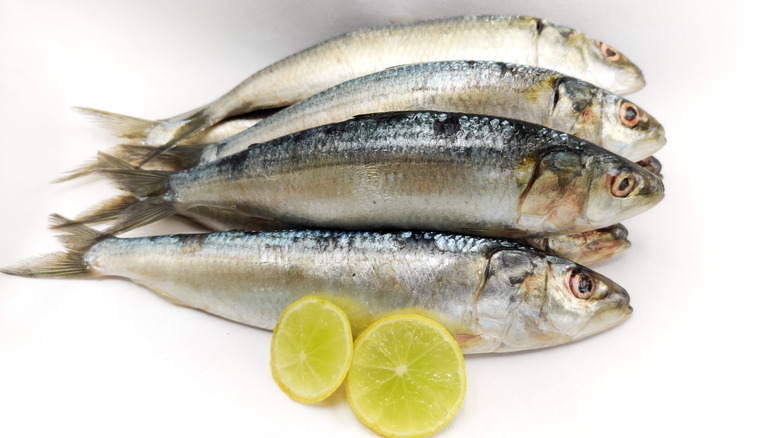14 Facts About Sardines You Should Know
When it comes to seafood, sardines might not be the first fish that comes to mind. Often overshadowed by their larger and more popular counterparts, these small, unassuming fish have been underestimated for far too long. The humble sardine has a storied history that dates back to ancient times. A beloved staple in many coastal communities around the world, their nutritional benefits and delicious taste have been celebrated for generations, especially in the Mediterranean region, eastern Atlantic Ocean, and north Pacific.
According To Adrienne Cheatham, sardines are the most underrated fish you should be cooking with for your meals. Sardines can bring a unique and delicious twist to your favorite recipes, whether it's a classic grilled sardine, flavorful sardine pasta, or sardines in saor. Furthermore, the canning process preserves nutrients and flavor, ensuring that you can enjoy the benefits of sardines year-round, even if they're not in season.
Sardines are a type of small, oily fish
Sardines are small, oily fish that have found their way onto plates all across the globe. One thing that sets sardines apart from other fish is their petite size. Usually measuring around 6 to 12 inches, they're sometimes called "pilchards" in certain parts of the world. Sardines have a sleek, cylindrical body with sharp snouts and a smattering of spiny fins. They sport a shimmering silver coat with a touch of blue-green on their backs.
Despite being frequently compared with anchovies, there are a number of key flavor differences between sardines and anchovies. Sardines are known for their subtle, slightly sweet taste, making them a delicious and versatile ingredient. On the other hand, anchovies pack a salty punch. Sardines can also be a sustainable food source that won't leave a heavy ecological footprint, depending on how they're harvested. Their numbers are healthy in many parts of the world thanks to developing sustainable fishing practices that are used to catch them. By looking for labels like those from the Marine Stewardship Council, you can indulge in these little fish guilt-free, knowing you're doing your part for the environment while treating your taste buds to something delightful.
Sardines are not a single species of fish
It's possible that when most people hear the word "sardine," they'll automatically picture just one specific fish. However, the term encompasses a variety of fish species that share certain traits which make them tasty and nutritious for humans. For instance, the European pilchard is one type of fish often called a sardine. It's a fish that lives in the eastern Atlantic and Mediterranean waters and is a beloved food source in many Mediterranean countries. People in these regions typically grill or fry the pilchard and serve it with zesty lemon and aromatic herbs.
Another species is the Pacific sardine, which has a rich flavor and high oil content. Found in the eastern Pacific Ocean, this small silver-colored fish is often canned or smoked and used in various traditional Mexican and Central American dishes. In addition to the European pilchard and the Pacific sardine, several other fish are commonly known as sardines. These include the round sardinella, the Indian oil sardine, and the South American pilchard.
Sardines are named after the Italian island of Sardinia
Sardines have been beloved seafood for centuries, but did you know they got their name from a place? Sardines are named after the Italian island of Sardinia, which used to be a major producer of these fish. Today, sardines are still a vital part of Sardinia's economy, with the island being a major producer of these little guys. Purse seine nets are typically used to catch them, allowing fishermen to capture large quantities of fish simultaneously. Once the sardines are caught, they are cleaned, gutted, and canned or sold fresh.
Aside from their economic significance, sardines also play a crucial role in Sardinian cuisine. Many traditional dishes on the island feature sardines as a star ingredient. Take, for instance, a bucatini con le sarde recipe, which is a lip-smacking pasta dish that combines sardines, fennel, pine nuts, and raisins. Or, there's bottarga di muggine, a type of fish roe made from the eggs of grey mullet that pairs perfectly with sardines.
Canned sardines have very long shelf life
When it comes to sardines, canned versions are a real game-changer. Unlike their fresh counterparts, which spoil quickly and must be gobbled up within a few days of purchase, canned sardines can last for years if stored correctly. That's because the canning process involves cooking, cleaning, and packing the fish in oil or water. The can is then sealed and sterilized using heat, eliminating bacteria or microorganisms that could lead to spoilage. This keeps sardines fresh for longer. However, some brands can last even longer. Some folks have reported that their canned sardines are still tasty and safe to eat after being stored for five years or more!
This lengthy shelf life makes canned sardines a godsend for people who want to stock up on non-perishable items or prepare for emergencies. They're also ideal for people who don't have easy access to fresh fish or seafood. But do keep in mind that canned sardines, like other foods, lose nutritional value over time. The longer they're stored, the more the nutrients can break down.
Sardine oil can be used to treat skin conditions
Sardine oil is extracted from the fatty tissues of sardines and contains various nutrients such as omega-3 fatty acids, vitamin A, etc. As more individuals turn to natural solutions for various skin conditions, sardine oil has thus become a popular ingredient in skincare products. Sardine oil can effectively treat chronic skin conditions such as eczema, which can cause red and inflamed patches on the skin. By reducing inflammation in the skin, sardine oil can help alleviate eczema symptoms and promote healthier skin.
Sardine oil can also help treat common skin conditions caused by the buildup of dead skin cells in the pores. Sardine oil can help prevent and treat acne by reducing inflammation and regulating oil production, leaving your skin looking clear and healthy. You can find sardine oil in different skincare products, including moisturizers, serums, etc. Additionally, sardine oil supplements can be ingested to promote overall skin health and reduce inflammation.
The canning of sardines was pioneered in the late 18th century in France
While sardines have been consumed for thousands of years, the pioneering efforts in the late 18th century in France made sardines more accessible and convenient for people around the world. Before the advent of canning, sardines were primarily preserved through methods such as drying, smoking, and salting. While these methods effectively preserved the fish, they often altered the taste and texture, limiting the culinary potential of sardines.
The canning of sardines can be traced back to the work of Nicolas Appert, a French confectioner and chef often credited as the "Father of Canning." After years of experimentation, Nicolas Appert discovered that food can be preserved by heating it in a sealed container. This process, known as "appertisation," laid the foundation for modern-day canning. The success of canned sardines in France soon spread to different nations, including the United States. The canning process made it possible to distribute sardines to a broader audience, making this delicious fish a staple in households worldwide.
Sardines are rich in selenium
Selenium is a trace mineral required in small amounts for proper health, but it plays a significant role in various bodily functions. You might be surprised to know that a 3.5-ounce (100-gram) meal of sardines provides 70% of the adult's daily selenium requirement. This makes sardines a convenient and delicious way to ensure you're meeting your daily selenium needs.
Selenium also supports a healthy immune system by regulating the production of immune cells. Furthermore, selenium plays a critical role in maintaining proper thyroid function. Hormones produced by the thyroid gland control metabolic rate and development. You can help ensure adequate selenium intake and support optimal thyroid function by consuming sardines in many ways, though grilled or canned options will have less of the same downsides as frying the fish. While selenium is necessary for health, an excess can be harmful. However, it would take a lot of sardines to surpass the recommended selenium level; therefore, the risk is negligible.
Sardines have a unique flavor profile that is described as both salty and savory
Sardines have a distinct taste that distinguishes them from other small fish like anchovies and mackerel. Grilling or frying sardines whole can enhance their natural flavor and create a crispy, delicious skin. Meanwhile, canned sardines may taste slightly differently due to the oil or sauce they are packed in. Sardines owe their savory flavor to the presence of glutamates, an amino acid that contributes to the umami taste. Since sardines are naturally fermented fish, they contain high levels of glutamate. Meanwhile, the saltiness of sardines comes from the seawater they inhabit. As they feed on plankton and other small fish in the open ocean, this diet, combined with the saltwater environment, gives sardines their unique briny flavor.
The versatility of sardines is reflected in their use as a flavorful ingredient in various dishes, from sandwiches to pizzas. In Mediterranean cuisine, sardines are often paired with olives, capers, and tomatoes to create delicious and healthy meals. Sardines are also an excellent option for those following a low-sodium diet. While they are naturally salty, they are still a good source of protein without the added sodium found in many processed foods. Canned sardines can even be rinsed with water to remove excess salt, making them an even healthier option for those watching their sodium intake.
Sardines can help improve heart health
Sardines are a nutritional powerhouse, and their high omega-3 content is one of the many reasons they are considered a heart-healthy food. Sardines are an exceptional source of EPA and DHA, known for their numerous health benefits, particularly in supporting cardiovascular health. High levels of triglycerides, a type of fat found in the bloodstream, can increase the risk of heart disease. Omega-3 fatty acids can help lower triglyceride levels, making sardines a heart-healthy food choice.
Sardines can help improve cholesterol levels by increasing HDL cholesterol levels, commonly known as "good" cholesterol. LDL cholesterol, or "bad" cholesterol, is removed from the body by HDL cholesterol. This makes it less likely that plaque will clog the arteries and cause cardiovascular diseases. It's important to note that while sardines offer significant heart health benefits, they should be consumed as part of a balanced, heart-healthy diet that includes a variety of fruits and vegetables.
Sardines are very low in mercury
In today's world, concerns about the potential dangers of consuming certain types of seafood are becoming increasingly prevalent. One of the primary concerns is the presence of mercury in fish, which can have harmful effects on human health. Mercury is a toxic metal that accumulates in a fish when it consumes a number of smaller organisms that contain mercury. Consuming such mercury-heavy fish every day can pose a significant health hazard to people due to the accumulation of mercury over time.
The good news is that sardines are among the fish with the lowest mercury content. This is because sardines are small, short-lived fish that feed on plankton rather than other fish. As a result, they do not accumulate significant amounts of mercury in their bodies. In fact, sardines are so low in mercury that they are considered one of the safest fish to eat. Thus, you can enjoy these tiny, nutrient-packed fish without worrying about the mercury-related health concerns associated with eating larger fish, like tuna or swordfish.
The annual Feast of St. Anthony in Portugal features a parade of giant sardines made of paper or plastic
The Feast of St. Anthony, or "Festas de Santo António," is an annual celebration that takes place in Portugal, with the most prominent festivities occurring in the capital city of Lisbon. The feast is marked by lively street parties, traditional music, dancing, and delicious Portuguese cuisine, strongly emphasizing the ever-popular sardine. During the Feast of St. Anthony, a vibrant parade of giant sardines made of paper or plastic can be seen weaving through the streets of Lisbon.
Each year, the parade features a different theme, and artists are encouraged to design their giant sardines accordingly. Past themes have included historical events, famous personalities, and even environmental messages, allowing artists to express their creativity while still honoring the sardine's cultural significance. The result is a diverse array of colorful and imaginative sardine sculptures that captivate locals and visitors alike. The parade of giant sardines is just one aspect of the Feast of St. Anthony.
This lively celebration also includes many food stalls offering traditional Portuguese dishes, many of which feature sardines as the main ingredient. From the classic grilled sardines drizzled with olive oil and sprinkled with sea salt to innovative sardine-based dishes, the Feast of St. Anthony provides a unique opportunity for visitors to sample the many delicious ways that sardines can be enjoyed in Portuguese cuisine.
Sardines were once considered a poor man's food in some cultures
Sardines gained popularity among American workers during the Great Depression. As the canned sardine business grew in the 1930s, it became a cheap and easy way for people who couldn't afford more expensive foods like meat to get nutrition. The fish were packed into small cans, often called "penny cans," because they were affordable. These cans provided an affordable, shelf-stable food option that could be stored for extended periods and easily transported.
In the United Kingdom, sardines were also known as the "poor man's food" due to their affordability and widespread availability. For many Britons, sardines were a staple food item that provided essential nutrients, particularly during World War II when food rationing was in effect. Sardines were not subject to rationing, and their popularity soared. As people have become more health-conscious, sardines have found their way onto gourmets and food enthusiasts' plates. Chefs worldwide have embraced sardines, showcasing their unique flavor in creative dishes that elevate the humble fish to new culinary heights. Sardines have come a long way from their "poor man's food" status, and they now proudly hold their place among the most esteemed seafood delicacies.
Sardines are rich in calcium and can help support bone health
Calcium is a mineral that plays a critical role in maintaining the health of our bones and teeth. The human body requires an adequate supply of calcium to build and maintain a strong skeletal structure. This high calcium content in sardines can be attributed to tiny, edible bones within the fish. These bones are pretty soft and get easily incorporated into the texture of the fish when cooked or canned. This means you can enjoy a tasty, calcium-packed meal without unpleasant crunching.
You might wonder why we should opt for sardines over other calcium-rich foods like milk or yogurt. The answer lies in the bioavailability of calcium in sardines. Sardines have higher bioavailability than dairy products, so the body can absorb and use them better. This makes sardines a fantastic option for those who are lactose intolerant or looking for non-dairy sources of calcium. In addition to calcium, sardines also provide a variety of other nutrients that support bone health. One such nutrient is vitamin D, which helps calcium absorption and bone mineralization. The body cannot absorb calcium effectively without adequate vitamin D levels, resulting in weaker bones. Another essential nutrient for bone health found in sardines is phosphorus. Phosphorus works together with calcium to build and maintain strong bones and teeth.
Sardines have been used in traditional medicine for their anti-inflammatory properties
While sardines are well-known for their culinary versatility and nutritional value, many people are unaware that sardines were used in traditional treatments to reduce inflammation and improve health. Throughout history, various cultures have relied on the healing properties of sardines to treat a variety of ailments. In ancient Greece, sardines were consumed to promote vitality and relieve joint pain. Similarly, in Ayurvedic medicine, a traditional Indian healing system, sardines were praised for their anti-inflammatory and pain-relieving effects.
So, what makes sardines so effective in combating inflammation? The secret lies in their high omega-3 fatty acid content, particularly eicosapentaenoic acid (EPA) and docosahexaenoic acid (DHA). Because of their potent anti-inflammatory effects, sardines are a fantastic food choice to include in a nutritious diet, particularly for people who struggle with persistent inflammatory problems. Another noteworthy anti-inflammatory compound found in sardines is coenzyme Q10 (CoQ10). This strong antioxidant helps cells create energy and reduces cytokines that promote inflammation. CoQ10 levels tend to decline with age, making it even more crucial to include sardine-rich foods in our diets as we grow older.
Static Media owns and operates Tasting Table, Daily Meal, and Mashed.
